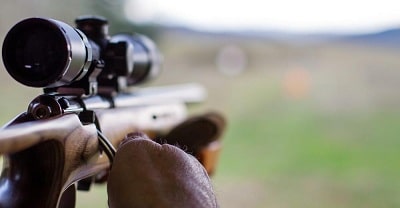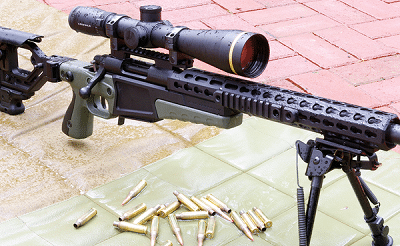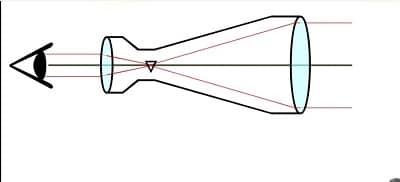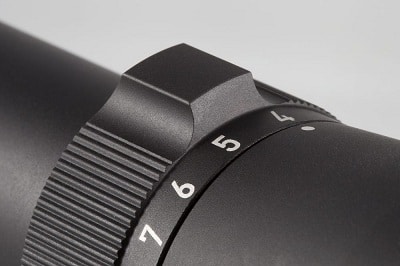So you’re looking into rifle scopes. You’ve decided that you need increased visibility when out in the field, making your gun that much more effective.

Unlimited guide about rifle scope
This is your guide all about rifle scopes, how to use them, how to measure them, and how to read the measurements.
I’ve been using rifle scopes for years, and have tried many low and high power scopes. These days, I prefer the lower power scopes whenever they are applicable. Let’s take a look at what rifle scopes can do for you.
In this post, we will help you find the answer for 7 question about rifle scopes: (use quick navigation to jump to answer)
- 1. Type of rifle scope
- 2. How does a Rifle Scope work
- 3. How are Rifle Scope Measured?
- 4. What do the numbers on a rifle scope signify?
- 5. Best times for Hight and Low Power rifle scope
- 6. What is the magnification? And how to read Scope Magnification?
- 7. How much Scope Manification do I need?
1. Types Of Rifle Scopes

6.5 creedmoor with rifle
Rifle scopes are meant to provide magnification on the rifle where a gun sight can’t, which is the main difference between the two.
Rifle scopes are distinguished by how they help the shooter hone in on their target, and typically fall into one of the following categories:
- Aperture sights require the shooter to set the front sight in line with the ring during the aiming process. The rear sight is typically a ring
- Open sights are similar in that the shooter must line of front and rear sights. However, instead of a ring for the rear sight, it appears as looking like the letter “V.”
- Dotted and laser sights help the shooter aim by pointing directly to the target with a noted mark. Red dot sights show a red dot on the target without actually sending any light out of the scope, making them ideal for hunting while maintaining camouflage. Laser sights actually project the image onto the target via laser
2. How Does A Rifle Scope Work?
Rifle scopes are elongated spaces for magnification lenses.
Their overall goal is to increase the line of sight on a shooter’s target through the magnification, and they work kind of a like high-tech magnifying glass. The central part of the rifle scope is called the main tube. This part holds the magnifying lenses that actually make the scope function properly. They also typically have some type of reticle for noting the point of impact of a bullet on the target.

How Does A Rifle Scope Work
Rifle scopes are attached to the top of the rifle and have an erector tube working between the reticle and adjustment knobs. This is how the scope adjusts its views, as the tube is moved back and forth by the shooter by the knobs. The shooter can zoom in on the target to their preference, finalize their aim, and take the shot. The eyepiece of the rifle scope is called the ocular assembly. The diopter here brings the shooter’s line of sight into focus, which is adjusted by the knobs. This all sounds very technical, but it basically operates like a telescope. The image, in this case the target, is fetched by the scope and brought into focus by the rest of the components. In the end, the shooter has much better visibility and a result, improved accuracy. Rifle scopes are preferable for long range shooting both in the field and at practice ranges
This video Airsoft GI talk about how does a rifle scope work:
3. What Do The Numbers Mean On A Rifle Scope?
This is where rifle scopes can be quite confusing. Because of their different parts, the scope improves the shooter’s line of sight in multiple ways.
Those ways are reflected in the measurement equation.
The measurement of rifle scopes is broken down into segments that basically translate a math equation.
The first number of note is the first digit, which depicts the level of magnification the scope presents.
So if a scope begins with the number “3”, that means that the target appears 3 times closer than it would without the scope.
The next digit is a dash, followed by a number representing ‘power.’ So if the number is 6, the power of the scope brings the target into focus appearing six times closer to the shooter than it would without a scope.
You’ll then have an ‘X’ followed by a number such as ’40.’ This last number refers to the diameter of the scope as measured in millimeters. Written out completely, this expression would read 3-6x40. Now you know what all those numbers mean!
What does 3-9x40 mean for a rifle scope:
In a 3-9X40 scope, the 3 means 3 power, or 3X. Clearly, this means that the image you see through the scope appears three times (3X) closer than it does with your naked eye. The 9 means nine power, or nine times (9X) closer than it appears with your naked eye. The (40) in this number is the objective lens diameter in millimeters. This is a variable scope because you can vary the magnification of the scope from 3 to 9, stopping anywhere in between. You would describe this scope as a "three to nine by forty." Some scopes have a 3x magnification range such as a 3-9. Some have 4 or more as in a 4-12. . The larger the magnification range the more you will pay, but it makes for a more versatile scope. I've been spoiled by them.
4. Best Times For High And Low Power Rifle Scope
There are different scopes for different hunting situations. Shooters will want a lower power scope, in most circumstances, for short range shooting.
Low power scopes are dialed down to their lowest magnification level possible, which helps to keep targets in focus that aren’t very far away. Police and armed military personnel often prefer low power scopes in typical day-to-day situations where they aren’t going to fire at targets that are hundreds of feet away.
High power rifle scopes are ideal for long-range shooting. They have the ability to, through multiple levels of magnification, increase the size of a target while making it appear to be closer than it actually is.
This gives the shooter the ability to not only have an easier time aiming at their target, but to pinpoint the exact area that they want to shoot. For example, the right side versus the left side, or a shoulder shot, etc.
5. What Is The Magnification? And How To Read Scope Magnification?
As we’ve stated here, the best way to read lens magnification is to determine how amplified you want your vision of the target to be.

What Is The Magnification And How To Read Scope Magnification
If you want the target to appear closer and also be bigger in your eye, focus on the entire sequence of numbers used to describe the rifle scope. Is the scope going to provide 3 levels of magnification, making the target highly visible from hundreds of yards away?
You’ll notice that the when reading lens magnification, the factors multiple each other. This is because they each complement the work of the other to provide a better shot.
Making a target appear larger while also making it appear closer provides more assistance to the hunter than simply zooming in on its head.
Read the listing like you read the description of your gun. 3-9x40 equals 3 times magniciation, 9 times closer to the shooter, all viewed through a lens that is 40 millimeters in diameter.
6. How Much Scope Magnification Do I Need?
The level of scope magnification needed depends mostly on how far away the target is going to be.
For closer targets, you’ll want a low power rifle scope that doesn’t severely alter the perception of the target.
It allows the target to appear mostly as it is, with slight enhancements to hone in on exactly where you want to shoot it.
You’ll want to increase the levels of magnification in line with targets getting further and further away, or if the targets are incredibly small.
Smaller targets need the amplification that makes them appear to be bigger than they are, allowing you to specifically shoot where you want to hit the target.
7. How Are Rifle Scopes Measured?

How Are Rifle Scopes Measured?
Rifle scopes are measured by how many times greater one’s vision and is of their target compared to what it would be with the naked eye. Levels of magnification are determined in comparison to the average person’s eyesight.
You may have a scope that improves the size of the image by 3 times, while making it appear 6 times closer to you than it actually is. You may have a scope that is 40 millimeters in diameter, or it may be bigger or smaller. In total, rifle scopes are measured by magnification and size, and depicted in the written form we’ll go over next.
8. Understanding About Adjustable Objective Scopes
Adjustable objective scopes can be somewhat confusing, but they really don’t have to be. Many shooters don’t fully understand them, but in this article, we will explain these scopes for you.
When a scope has an adjustable objective, it simply means that it has an adjustable parallax. Parallax can be confusing as well. Essentially, parallax becomes a problem when shooting at longer distances. If your eye, the reticle, and the target aren’t lined up, it will appear that the reticle is somewhere that it actually isn’t.
Many scopes come with a set distance at which there will be no parallax. Essentially, the lenses of the scope are lined up in a way that the reticle will be perfect at that distance. Adjustable objective scopes allow you to change this distance.
In order to effectively use an adjustable objective scope, you must know the distance that you’re shooting at. You’ll need a rangefinder or a known distance target to do this. However, once you’ve zeroed the scope in and identified the distance, you’ll be able to adjust the rifle to a point where it should be parallax free at the specified distance. Once the scope is parallax free, it doesn’t really matter where your head is placed. It eliminates the need for your eye to be perfectly lined up with the scope.
For precision shooting, this is a huge positive. Military snipers adjust the parallax of their scopes because it’s essential to have a precisely placed shot. However, for hunters, this usually isn’t a huge problem, because extremely precise shot placement isn’t necessary.
The biggest pros of an adjustable objective scope are that it allows you to be much more accurate, and it will make shooting at longer distances easier. On scopes with a higher magnification range, this could be extremely important, because parallax will be more noticeable at greater distance and at greater magnification.
The cons of this feature is that it can make the scope more confusing to use, and it may be completely unnecessary. With the additional knob, it may make the scope a little more confusing to use. You may find yourself messing with the settings too much, and eventually missing a shot that you would normall hit.
The only people who really should use adjustable objective scopes are those who require extreme accuracy. As we mentioned before, it is really only necessary for snipers and those who partake in precision shooting. If you’re a hunter, you can get by without it, but you could also use it if you’d like. For instance, if you’re hunting at a specific distance, you could set your parallax ahead of time to make the shot that much easier.
Conclusion
Rifle scopes have completely changed the game for shooters. Low power scopes seem to be rising in popularity these days as hunters realize that having more power than they need in terms of eyesight isn’t always a good thing.
Sometimes, it’s best to just go with instincts instead of overdoing it with extras. I hope you have found this post helpful – if so, please share on social media and feel free to comment below. Ideas and experiences are the stepping stones of progression. The more people we get talking, the better our hunting skills will be!

It can really surprise people when they go to buy a rifle scope only to realize how complicated it can be. There are several factors that must be taken into consideration when buying a rifle scope to make sure you’re choosing one that fits your needs. For example, you’ll probably want to make sure that you understand its magnification levels and how they work on the scope.
I still came away not finding an answer to my specific question, which is this:
With all other factors being equal, would I be better off buying a 3-9×50 scope, or a 2-7×40? The rifle on which it will be mounted (a custom AR15 , 20″ barrel, and chambered in .223 Wylde, will be used primarily for punching paper out to 300 yds.
Great job on this article. You have broken down the information in the exact manner that I was looking for.Thanks for taking the time to write this up.
I like that budget is the first thing in your steps. A scope/optic has to fir in most peoples budget somehow, and it’s very easy to spend more than you intended. At this time, I only have one rifle fitted with an optic, and that’s my AR 15. While I look, watch and drool with envy over the number of high end scopes and optics, spending 4 figures for use on a $900, just isn’t an expense a retiree can easily justify. I have both a scope and a holographic Red Dot on quick mounts. The scope is a Vortex Diamondback Tactical Rifle, with 4 – 16x, the Red Dot a Vortex Venom 1x. I’ve had both for about 5 years now, and other than replacing batteries, no issues to date with either.
This post will assist the internet people for creating new webpage or even a blog from
start to end.
I enjoyed this article a lot! Very practical, down-to-earth steps. I always wondered about the Firefield rifle scope, this website reviewed this particular rifle scope and the results and ratings was pretty good (https://www.pointoptics.com/firefield-riflescope-review/). What are your thoughts towards this specific rifle scope? Thx
I’ve been looking for information about being fully zoomed on a target 50yrds away and shooting low. Especially with a 10 or 12 power scope
I’ve been shooting many years . I was in the United States Army for thirty years almost twenty in the Ranger Regiment. I retired I in 2010 .I was trained peep sights. I didn’t do much shooting while on active duty. Now I can shoot for recreation. I have a Monstrum 1-4 on a Ruger mini14. I’ve also have a Marlin 444lever rifle that I used Skinner sights on for many years. With these old eyes. I just put a 3-9x 40 on that. Now I can hit 250 yards consistently. I have the AO on both scopes. It seems to clrarify shots to focus especially while shooting in the woods. At a marked range you don’t need it. I also put them no two high power pellet rifles break barrel springers.I don’t hunt because I don’t get around so well anymore. Don’t like the blood sport anymore.I would hunt to feed my family. But no trophy hunting. Now I shoot paper targets and clay pigeons occasionally.
Thanks for your detailed sharing. I have searched for the rifle scope for a long time and all information I know is all on your article. Understanding deeply about it is the best way to have the best one.
Greatly answered each question, highly appreciated!
Thank you for making the geometry & math of scopes so simple and easy to understand. After reading it carefully it seems my Zeiss 4×9-40 is plenty of scope for what i need on my Creedmore 6 rifle.
I am still not sure the exact maximum range I can expect for the 9x magnification. Can u help with that?